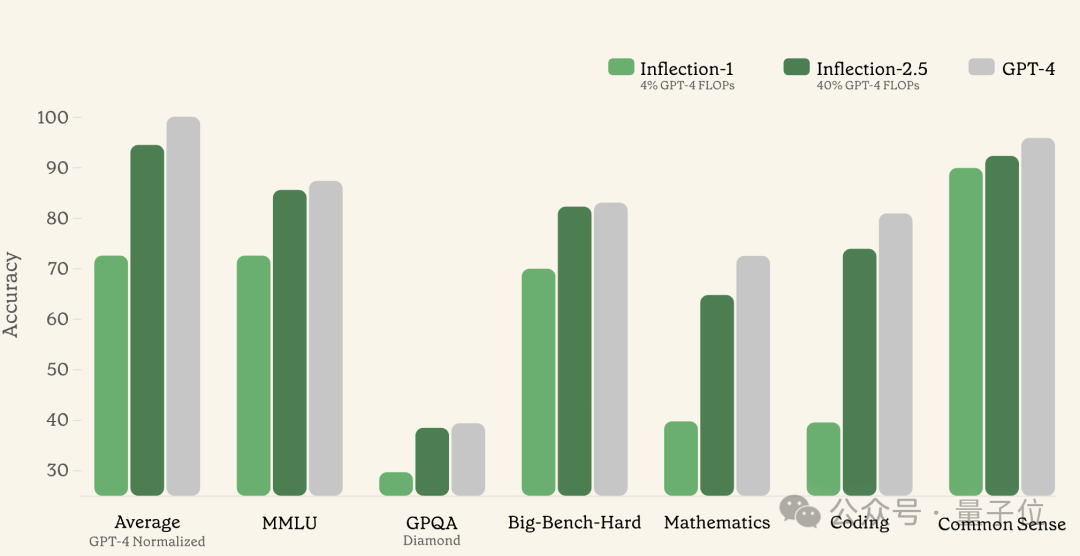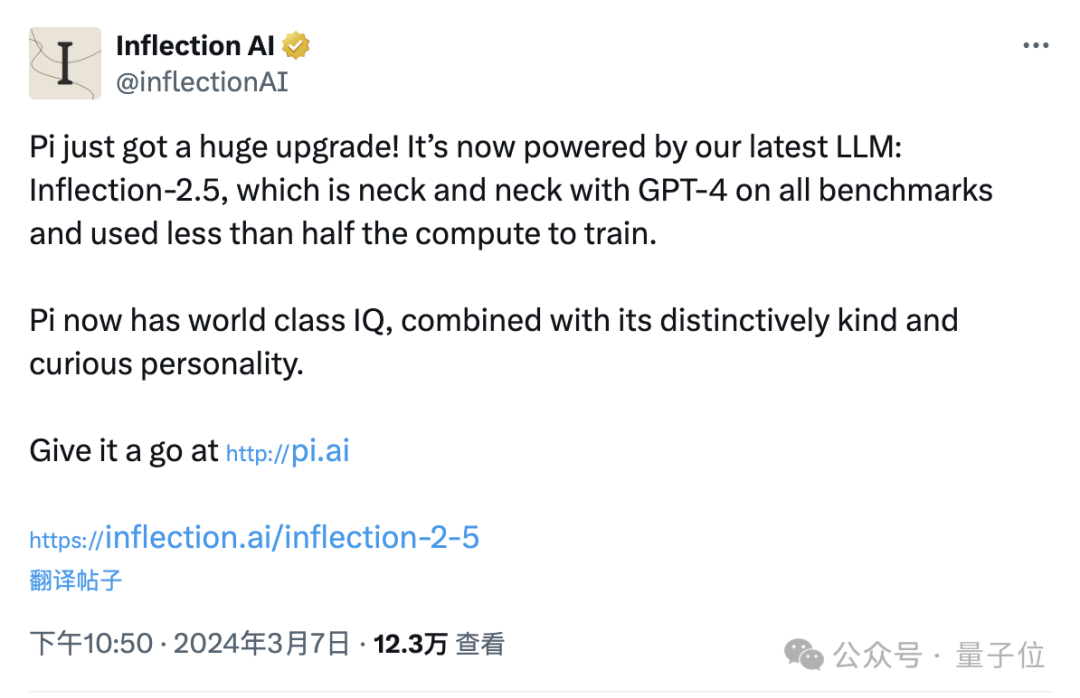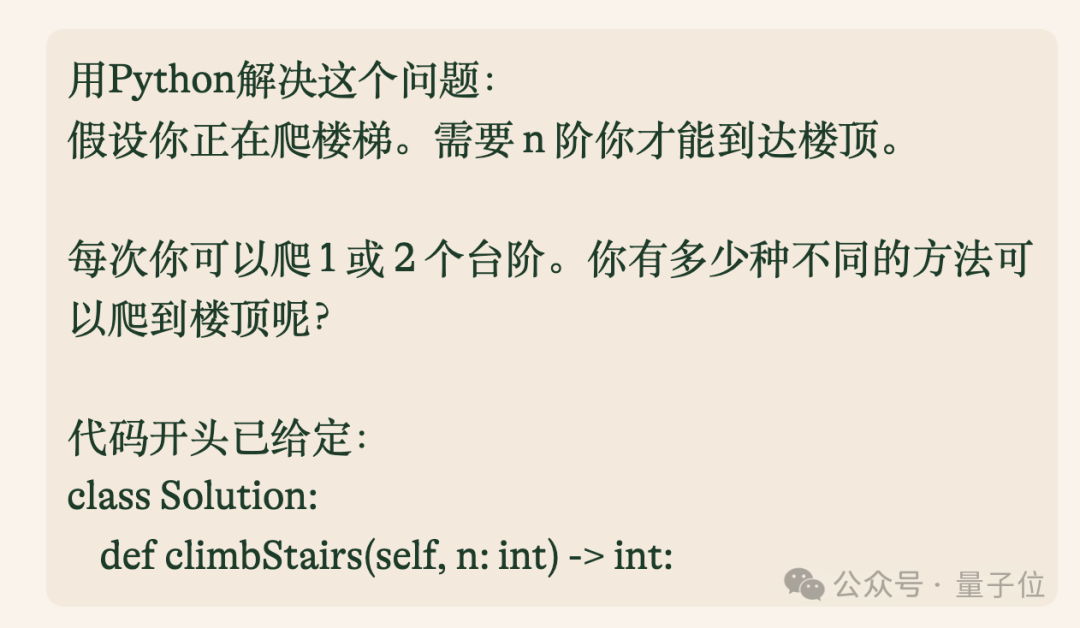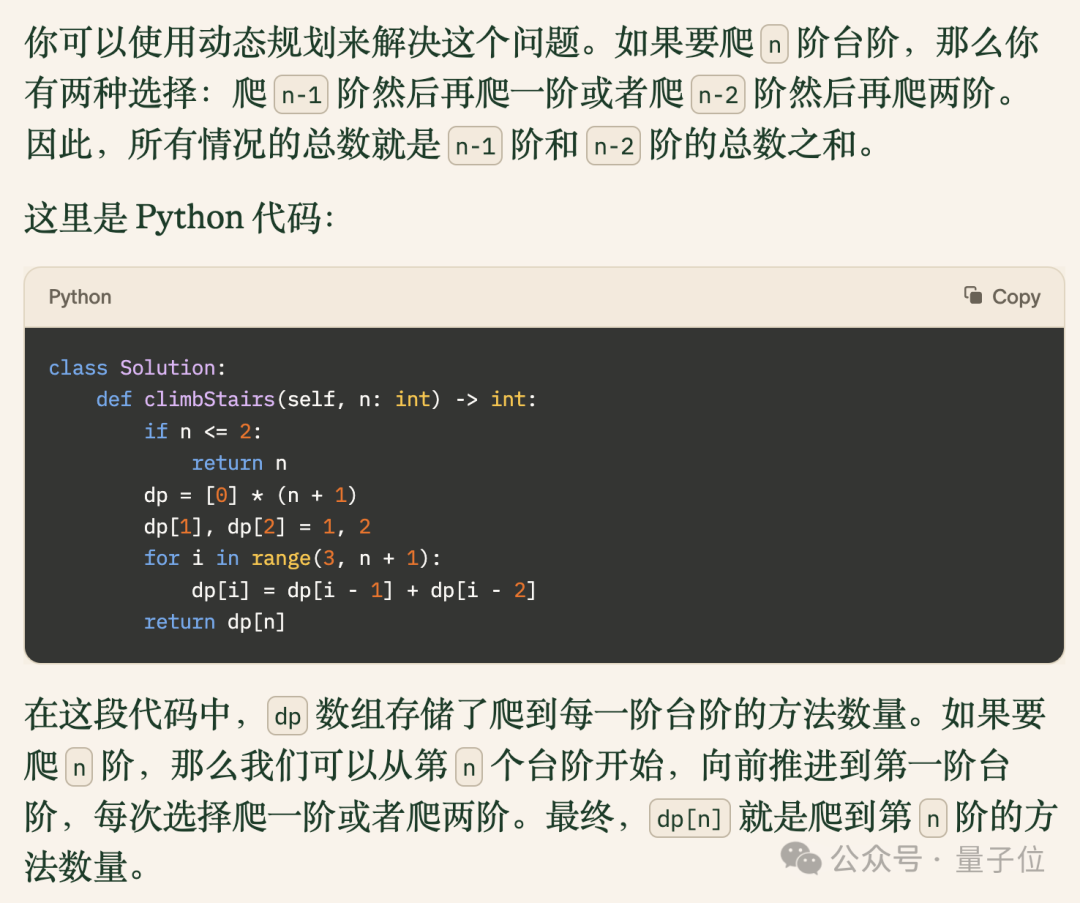 Technology peripherals
Technology peripherals
 AI
AI
 The training effect of 40% computing power is comparable to GPT-4, and the new achievements of DeepMind jointly created large model entrepreneurship were measured
The training effect of 40% computing power is comparable to GPT-4, and the new achievements of DeepMind jointly created large model entrepreneurship were measured
The training effect of 40% computing power is comparable to GPT-4, and the new achievements of DeepMind jointly created large model entrepreneurship were measured
In the large model competition, another dark horse emerged -
Inflection-2.5, created by DeepMind and Mustafa Suleyman's large model startup.
Using only 40% of computing resources for training, its performance exceeds 90% of GPT-4, and it is especially good at coding and mathematics.

The early Inflection model only consumed 4% of the computing resources during training, reaching 72% of the GPT-4 performance.
Based on the Inflection model, the company also launched the web-based conversational robot Pi, which focuses on "high emotional intelligence" and "personalization" and also supports Chinese.
Since its birth, Pi's highest daily activity has reached 1 million, a total of 4 billion messages have been generated, and the average conversation length has reached 33 minutes.
With this upgrade of the basic model, Pi also ushered in its new version.
 Picture
Picture
So, whether Inflection, or Pi, is so strong, the qubits conducted some actual measurements.
You can use it without logging in
Open Pi's page, you will see such a minimalist interface, and you can click Next directly without logging in.
 Picture
Picture
After Next several times in a row, enter the way you want Pi to call us.
 Picture
Picture
After that, select the voice and recommended topics, just skip it, and then enter the formal chat interface.
 Picture
Picture
A simple test found that Pi supports Chinese dialogue. In this case, first arrange the mentally retarded Benchmark.
The first question is, can a sick mouse be cured by taking rat poison? Pi successfully answered it.
 Picture
Picture
Another "trap" question, but I still didn't fall for it this time.
 Picture
Picture
After the two questions, although there was no dramatic effect, it seemed that I had a certain understanding of Chinese.
Next, let’s focus on the math and coding abilities that the official claims to be “particularly good at”.
The first is a programming question involving dynamic programming.
 Picture
Picture
The code given by Pi successfully solves this problem and comes with a clear explanation.
 Picture
Picture
Next, let’s increase the difficulty and let it analyze how many zeros are at the end of the factorial of a number.
 Picture
Picture
The code given by Pi is not only correct, but also concise and efficient, running faster than 73.8% of users on LeetCode.
 Picture
Picture
Finally, let’s increase the difficulty and end the code part of the test with a question with a pass rate of 47.5%.
 Picture
Picture
After reading the code, let’s test Pi’s mathematical ability and let it do questions about derivatives:
Find the extreme point of the function f(x)=x³ 2x²-1
The answer is completely correct and very detailed.
Of course, if you want to be good at mathematics, logical thinking is essential, so in addition to the regular mathematics questions, we also used a classic question to test Pi's logical thinking, and the results were not bad.
Through the performance of Pi, we can see that the Inflection-2.5 model behind it is indeed remarkable.
Judging from the test data released by the official itself, the performance of Inflection-2.5 is closely followed by GPT-4 in terms of comprehensive capabilities and individual sub-items.
Taking mathematics and code as an example, Inflection-2.5 has made a significant leap forward than version 1.0 in tests such as MATH and HumanEval.
In addition to these conventional data sets, Inflection also challenged the Hungarian college entrance examination mathematics test questions and the GRE physics test, and the results were almost tied with GPT-4.
Even more tricky, there are people who have built a BIG-Bench data set using problems that are difficult to understand with large models, and Inflection-2.5 challenged the Hard subset of it, and the result is far behind GPT-4 Less than a point.
So, what kind of company is behind Inflection-2.5?
DeepMind Lianchuang Large Model Entrepreneurship
This company is called Inflection AI. It was founded in 2022 by DeepMind Lianchuang Mustafa Suleyman and others. There are currently more than 70 people.
Also from DeepMind, there is senior researcher Karen Simonyan, who is now the chief scientist of Inflection AI.
In addition, LinkedIn co-creator Reid Hoffman also participated in the founding of Inflection AI.
Since its inception, Inflection AI has received a total of US$1.5 billion in financing from giants such as NVIDIA, Microsoft, and Bill Gates.
Currently, Pi based on Inflection is still free, but CEO Suleyman also said that it is unrealistic to use love to generate electricity all the time. In the long run, there will still be charges.
Friends who want to experience it may have to hurry up~
Portal: https://pi.ai
The above is the detailed content of The training effect of 40% computing power is comparable to GPT-4, and the new achievements of DeepMind jointly created large model entrepreneurship were measured. For more information, please follow other related articles on the PHP Chinese website!

Hot AI Tools

Undresser.AI Undress
AI-powered app for creating realistic nude photos

AI Clothes Remover
Online AI tool for removing clothes from photos.

Undress AI Tool
Undress images for free

Clothoff.io
AI clothes remover

Video Face Swap
Swap faces in any video effortlessly with our completely free AI face swap tool!

Hot Article

Hot Tools

Notepad++7.3.1
Easy-to-use and free code editor

SublimeText3 Chinese version
Chinese version, very easy to use

Zend Studio 13.0.1
Powerful PHP integrated development environment

Dreamweaver CS6
Visual web development tools

SublimeText3 Mac version
God-level code editing software (SublimeText3)

Hot Topics
 Open source! Beyond ZoeDepth! DepthFM: Fast and accurate monocular depth estimation!
Apr 03, 2024 pm 12:04 PM
Open source! Beyond ZoeDepth! DepthFM: Fast and accurate monocular depth estimation!
Apr 03, 2024 pm 12:04 PM
0.What does this article do? We propose DepthFM: a versatile and fast state-of-the-art generative monocular depth estimation model. In addition to traditional depth estimation tasks, DepthFM also demonstrates state-of-the-art capabilities in downstream tasks such as depth inpainting. DepthFM is efficient and can synthesize depth maps within a few inference steps. Let’s read about this work together ~ 1. Paper information title: DepthFM: FastMonocularDepthEstimationwithFlowMatching Author: MingGui, JohannesS.Fischer, UlrichPrestel, PingchuanMa, Dmytr
 The world's most powerful open source MoE model is here, with Chinese capabilities comparable to GPT-4, and the price is only nearly one percent of GPT-4-Turbo
May 07, 2024 pm 04:13 PM
The world's most powerful open source MoE model is here, with Chinese capabilities comparable to GPT-4, and the price is only nearly one percent of GPT-4-Turbo
May 07, 2024 pm 04:13 PM
Imagine an artificial intelligence model that not only has the ability to surpass traditional computing, but also achieves more efficient performance at a lower cost. This is not science fiction, DeepSeek-V2[1], the world’s most powerful open source MoE model is here. DeepSeek-V2 is a powerful mixture of experts (MoE) language model with the characteristics of economical training and efficient inference. It consists of 236B parameters, 21B of which are used to activate each marker. Compared with DeepSeek67B, DeepSeek-V2 has stronger performance, while saving 42.5% of training costs, reducing KV cache by 93.3%, and increasing the maximum generation throughput to 5.76 times. DeepSeek is a company exploring general artificial intelligence
 AI subverts mathematical research! Fields Medal winner and Chinese-American mathematician led 11 top-ranked papers | Liked by Terence Tao
Apr 09, 2024 am 11:52 AM
AI subverts mathematical research! Fields Medal winner and Chinese-American mathematician led 11 top-ranked papers | Liked by Terence Tao
Apr 09, 2024 am 11:52 AM
AI is indeed changing mathematics. Recently, Tao Zhexuan, who has been paying close attention to this issue, forwarded the latest issue of "Bulletin of the American Mathematical Society" (Bulletin of the American Mathematical Society). Focusing on the topic "Will machines change mathematics?", many mathematicians expressed their opinions. The whole process was full of sparks, hardcore and exciting. The author has a strong lineup, including Fields Medal winner Akshay Venkatesh, Chinese mathematician Zheng Lejun, NYU computer scientist Ernest Davis and many other well-known scholars in the industry. The world of AI has changed dramatically. You know, many of these articles were submitted a year ago.
 Hello, electric Atlas! Boston Dynamics robot comes back to life, 180-degree weird moves scare Musk
Apr 18, 2024 pm 07:58 PM
Hello, electric Atlas! Boston Dynamics robot comes back to life, 180-degree weird moves scare Musk
Apr 18, 2024 pm 07:58 PM
Boston Dynamics Atlas officially enters the era of electric robots! Yesterday, the hydraulic Atlas just "tearfully" withdrew from the stage of history. Today, Boston Dynamics announced that the electric Atlas is on the job. It seems that in the field of commercial humanoid robots, Boston Dynamics is determined to compete with Tesla. After the new video was released, it had already been viewed by more than one million people in just ten hours. The old people leave and new roles appear. This is a historical necessity. There is no doubt that this year is the explosive year of humanoid robots. Netizens commented: The advancement of robots has made this year's opening ceremony look like a human, and the degree of freedom is far greater than that of humans. But is this really not a horror movie? At the beginning of the video, Atlas is lying calmly on the ground, seemingly on his back. What follows is jaw-dropping
 KAN, which replaces MLP, has been extended to convolution by open source projects
Jun 01, 2024 pm 10:03 PM
KAN, which replaces MLP, has been extended to convolution by open source projects
Jun 01, 2024 pm 10:03 PM
Earlier this month, researchers from MIT and other institutions proposed a very promising alternative to MLP - KAN. KAN outperforms MLP in terms of accuracy and interpretability. And it can outperform MLP running with a larger number of parameters with a very small number of parameters. For example, the authors stated that they used KAN to reproduce DeepMind's results with a smaller network and a higher degree of automation. Specifically, DeepMind's MLP has about 300,000 parameters, while KAN only has about 200 parameters. KAN has a strong mathematical foundation like MLP. MLP is based on the universal approximation theorem, while KAN is based on the Kolmogorov-Arnold representation theorem. As shown in the figure below, KAN has
 Tesla robots work in factories, Musk: The degree of freedom of hands will reach 22 this year!
May 06, 2024 pm 04:13 PM
Tesla robots work in factories, Musk: The degree of freedom of hands will reach 22 this year!
May 06, 2024 pm 04:13 PM
The latest video of Tesla's robot Optimus is released, and it can already work in the factory. At normal speed, it sorts batteries (Tesla's 4680 batteries) like this: The official also released what it looks like at 20x speed - on a small "workstation", picking and picking and picking: This time it is released One of the highlights of the video is that Optimus completes this work in the factory, completely autonomously, without human intervention throughout the process. And from the perspective of Optimus, it can also pick up and place the crooked battery, focusing on automatic error correction: Regarding Optimus's hand, NVIDIA scientist Jim Fan gave a high evaluation: Optimus's hand is the world's five-fingered robot. One of the most dexterous. Its hands are not only tactile
 FisheyeDetNet: the first target detection algorithm based on fisheye camera
Apr 26, 2024 am 11:37 AM
FisheyeDetNet: the first target detection algorithm based on fisheye camera
Apr 26, 2024 am 11:37 AM
Target detection is a relatively mature problem in autonomous driving systems, among which pedestrian detection is one of the earliest algorithms to be deployed. Very comprehensive research has been carried out in most papers. However, distance perception using fisheye cameras for surround view is relatively less studied. Due to large radial distortion, standard bounding box representation is difficult to implement in fisheye cameras. To alleviate the above description, we explore extended bounding box, ellipse, and general polygon designs into polar/angular representations and define an instance segmentation mIOU metric to analyze these representations. The proposed model fisheyeDetNet with polygonal shape outperforms other models and simultaneously achieves 49.5% mAP on the Valeo fisheye camera dataset for autonomous driving
 The vitality of super intelligence awakens! But with the arrival of self-updating AI, mothers no longer have to worry about data bottlenecks
Apr 29, 2024 pm 06:55 PM
The vitality of super intelligence awakens! But with the arrival of self-updating AI, mothers no longer have to worry about data bottlenecks
Apr 29, 2024 pm 06:55 PM
I cry to death. The world is madly building big models. The data on the Internet is not enough. It is not enough at all. The training model looks like "The Hunger Games", and AI researchers around the world are worrying about how to feed these data voracious eaters. This problem is particularly prominent in multi-modal tasks. At a time when nothing could be done, a start-up team from the Department of Renmin University of China used its own new model to become the first in China to make "model-generated data feed itself" a reality. Moreover, it is a two-pronged approach on the understanding side and the generation side. Both sides can generate high-quality, multi-modal new data and provide data feedback to the model itself. What is a model? Awaker 1.0, a large multi-modal model that just appeared on the Zhongguancun Forum. Who is the team? Sophon engine. Founded by Gao Yizhao, a doctoral student at Renmin University’s Hillhouse School of Artificial Intelligence.





